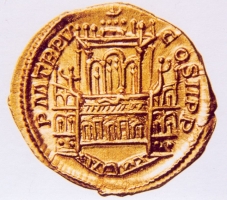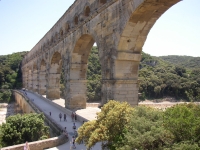


Costs
Originally, the money for the aqueducts came primarily from war-booty and from the patronage of wealthy individuals. Many of these would have made their fortune in war, or inherited it from an ancestor who did. The state also had income from the taxes imposed on conquered people, but this would become a more important source of funds during the empire. The sudden income from pillage was ideal to meet the outlay of money needed for aqueduct construction. Rome itself benefited most from this income. The aqueducts, and many other services, were never expected to pay for themselves, but were supplied to the people as a benefit (Aicher, 1995:26).The construction of the aqueducts caused a number of changes in the way the Republic's finances functioned. Erdkamp, in Rosenstein & Morstein-Marx (2006:284), states that the first issues of silver coins by Rome were minted in Campania around 310 BC. They were probably issued to pay for the construction of the Via Appia, but might also have been minted to pay for the Aqua Appia. Also, the Anio Vetus was paid for by the spoils of the Pyrrhic War, and was one of the earliest examples of a system of public finance which deliberately embellished the Roman state by means of war-booty (Ashby, 1935:41). This method of finance remained more-or-less intact for the duration of the Republic. Under the Empire, the Emperor took over responsibility for public works. At that time, private donations and taxation were also used to finance the construction. However, such a large drain on state and private purses without return on capital surely drained the wealth of the state and people of Rome.
Vitruvius' model for an aqueduct had private customers paying their water. This was actually the case in most towns. Rome was different. In Republican times the private use of aqueduct water was not prevalent. Only the overflow water (aqua caduca) was sold to private users. With the construction of new aqueducts in Imperial times, more water become available for private users. Much of this water was free, available in grants bestowed by the emperor. He would determine the amount - one of the standard calix sizes -, and send a letter of authorisation to the curator. The curator would give the job of installation to the procurator and his men. The grant was given to an individual, not to property, and it was not hereditary. If the individual died or the property was sold the water reverted to imperial discretion. Sometimes the aquarii sold the water in the interim for their own profit (Aicher, 1995:26). Some users continued to pay in Imperial times as they has in Republican. Frontinus records a yearly income of 250,000 sesterces from the sale of aqueduct water. He does not identify who these users are. Pipe inscriptions reveal that about half of the private users who were granted water belonged to the numerically fewer senatorial class. That these were precisely the people who could afford most to buy it is a standard feature of Roman patronage (Aicher, 1995:27).
According to Frontinus the money allocated for public works, including the Aqua Marcia, was 180 million sesterces, which may have been equal to four and a half years revenue (Evans, 2000:84). According to Frontinus, the term of his praetorship was not sufficient for the completion of the enterprise. As the Marcia is 91km, the cost was approximately two million sesterces per kilometre. Leveau (1991) estimates that it cost between one and three million sesterces per kilometre on average to build an aqueduct. Hauck (1988:153) estimated that the aqueduct of Nemausus (including the Pont du Gard) cost two million sesterces per kilometre. At approximately 50km, that would have cost in the region of 100 million sesterces. Thus, modern estimates seem to accord well with Frontinus' reported budget for the Marcia. However, Frontinus states that the Aqua Claudia and Anio Novus to have cost only 55.5 million sesterces. As the Claudia was out of operation within less than two decades of its construction, this may indicate that poor materials and workmen were used.
The cost, and duration, of the work was a function of the difficulties, i.e. tunnels, bridges, arcades, raised foundations, siphons, cascades, ground composition and so on. If Frontinus' figures can be relied upon, then the Marcia cost 1.966 million sesterces per kilometre, and the Claudia and Anio Novus 2.248 million sesterces per kilometre.
CIL 1.808 provides an idea as to the cost of building in Rome early in the last century of the Republic. Paving twenty miles of the Appenine road, starting with the 78th milestone, with gravel cost 150,000 sesterces. Another unknown length, but at least thirteen miles, cost 600,000 sesterces. Pliny (33.17), in his Natural History, tells us that at the beginning of the social war there was 1,620,831 sesterces in the public treasury. Caesar withdrew from the treasury 15,000 pounds of gold, 30,000 pounds of silver and 30,000,000 sesterces. We can see that the size of the public treasury could vary enormously, and one is lead to suspect that no exact figures have come down to us, if they ever existed. We can conclude that the cost of construction and maintenance was high, considering the relatively high costs of maintaining short sections of roads.
From the thesis of Evan J. Dembskey on The aqueducts of Ancient Rome